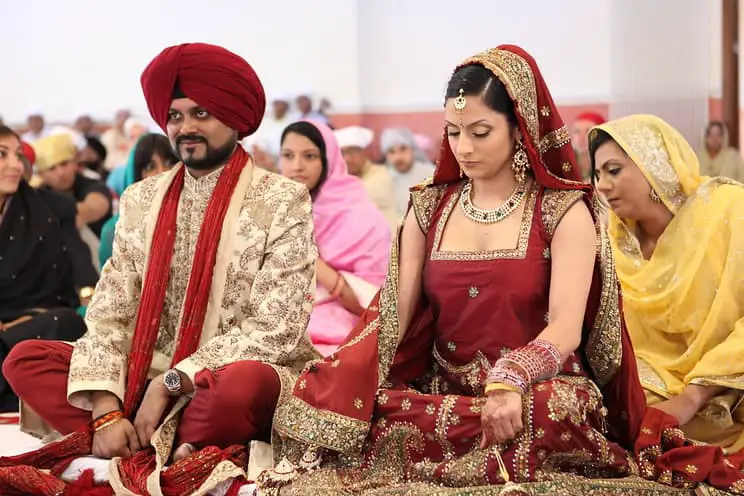
Being a Sikh woman, it was very important for my parents to follow the Sikh traditions when organizing my wedding ceremonies. To be honest with you, I was more than happy to follow suit. The Sikh ceremonies are not only traditional but, offer lots of fun at the same time. It is a great way of having your close family members be part of your big day.
Below I’ve listed the 22 Sikh wedding rituals which my family and I followed, from the engagement to the actual wedding. I have outlined below what each ritual is called in Punjabi and what it entails and the purpose of each tradition. The rituals are outlined in the order they took place.
The ceremonies can be as small or as large as you choose. I opted for the smaller more intimate pre-wedding ceremonies as that made it more personal for me. After all, we all know how large an affair an Indian wedding can actually become so, for me especially, it was just nice to have smaller, more intimate time with my immediate family members where I knew everyone and could spend some quality time with my them all. It also meant I could just be me and be more relaxed throughout the events.
1. Rokka (Pre-Engagement)
The Rokka is the very first ceremony that takes place and is the most important one too as it is basically signifies the start of the wedding Sikh rituals. The Rokka is not only for the bride and groom but, symbolizes the unity of the two families and friends – the brides and the grooms.
2. Kurmai (Engagement)
The Kurmai is the official engagement of the bride and the groom. It is very much a family matter and my Kurmai consisted of the immediate family members only. You could choose to have some close friends too but, this only increased the numbers and as my Kurmai was taking place at my parents’ home, so we limited this to only immediate family members.
The chunni is given by the bride’s in-laws. Sometimes the chunni is passed down from generation to generation and could even be considered an heirloom. As my husband was the first one to get married in his family, I had a new chunni which I still have. It was a lovely dark red color and heavily decorative.
Unfortunately, my mother-in-law was not well on this occasion, so my sister-in-law carried out this ceremony for me. She draped the chunni and gave me some jewelry. Normally it would be your mother-in-law to be who would carry out this ritual.
A delicate gold set, consisting of necklace and earrings were also bestowed to me. The jewelry given can be quite heavy and bold but, I actually wanted something simple and delicate that I could wear again and again. As with most Indian jewelry it can be very ornate and often is in 24ct gold. For luck, my sister-in-law applied mehndi (henna paste) to the palm of my hand and then my fiancé put the engagement ring on my finger and that confirmed our engagement.
My father put a tikka on my fiancé forehead as a way of giving us his blessings. Everyone congratulated us and gave us a small piece of matai (Indian sweets). The two families can, at this stage exchange gifts but, we chose not to do this. It is very much a personal choice, as to how much of the traditions you decide to follow and of course how deep your pockets are.
As a family, we had made the decision to although follow the Sikh rituals and traditions we would at the same time limit or cut down on them. Obviously getting married is a very expensive affair and therefore I did not wish my parents to have any unnecessary additional costs or be burdened with debt.
3. Sangeet
The bride and the bridesmaids are the focus of the Sangeet ritual. We held the sangeet at my family home and put a marquee in the garden. It was a beautiful simple white marquee which we decorated with some Indian decorations. Such as flower garlands, door hanging decorations hanging from the ceiling of the marquee as well as draped chunnis. The marquee looked beautiful and had that wedding feeling look about it too.
We invited very close family members and few of my closest friends. We shared the sangeet with the groom’s immediate family members only. The Sangeet is great fun with singing and dancing. My aunts played the dholki, (Indian drums), and sang songs which basically teased my fiancé and his family. We all had great fun, and everyone could join in from singing traditional songs to even just singing the chorus.
The dholki brings the traditional sound of the Indian drums which always takes pride and place in any wedding function. Dinner and drinks are always provided at any Indian function and at all traditional rituals. You can either opt and make the food at home or get in catering. We chose to get caterers in who provided and served the food as well as the drinks. This meant that everyone in the family could relax and enjoy the festivities, especially my mum.
As with all these rituals the costs can vary quite considerably. We opted for a more personal and intimate affair. Depending on each individual ‘pocket’, some couples to be now hire out halls, DJ’s and caters or hold the function in a restaurant or purpose built venues. They can add a theme to these rituals too, for e.g. Bollywood night. In addition, people include cocktails in their function as well.
You can basically hold these rituals anywhere; it just depends on how much you want to spend on each function as obviously cost is a major factor when arranging an Indian wedding as we tend to typically have in excess of 400 guests.
4. Mehndi
The Mehndi must have been one of my favorite rituals and is the last ritual before the wedding. Mehndi for the bride is provided by a mother-in-law which was packaged decoratively. Mehndi, which is henna paste can be bought ready made in a tube or a cone shaped container which is easy to use and apply.
Most people use the cones as they are easy to apply a pattern with and they are readily available and aren’t too expensive either. You can also get the mehndi in powder form.
One of the ways to make the powder mehndi darker, is to mix it with tea water and add clove or eucalyptus oil and leave it overnight to soak. As with all mehndi, whether bought or homemade, the longer you leave the mehndi the darker the color.
Whilst your mehndi is drying, it is advised that a mixture of lemon juice and sugar (ensure the sugar is thoroughly dissolved) is dabbed on the drying mehndi, using small cotton ball to stop it from cracking. Most brides have known to go to bed with their mehndi.
The mehndi can be incorporated with the Sangeet but, I choose to do my mehndi after the Sangeet and a day before the wedding. It was a very much a personal choice. Mehndi is only a temporary tattoo and will fade gently with every wash over time.
Mehndi can be applied by anyone without any formal training but, more often professional mehndi artists are hired on the occasion of weddings, especially for the bride. Sometimes an artist with lesser experience maybe hired to do the bride’s party members. You will find that maybe some of your guests are also very capable to applying an intricate design for other guests.
Traditionally the bride will have mehndi on both her hands and her feet. This can be applied as far as the bride’s elbows and up to the calves of her legs. The bride will have mehndi on both sides of her hands. An old wife’s tail is said to be that the darker the brides mehndi reflects the more love her mother-in-law will have for her.
I had my mehndi pattern up to my wrists and on my feet. It was a very intricate pattern and looked lovely. Like all brides I kept my mehndi on for several hours thus ensuring the color to be dark which lasted for a couple of weeks. I was lucky as my makeup artist was not only able to do my makeup but, was very versatile and did my hair and mehndi as well.
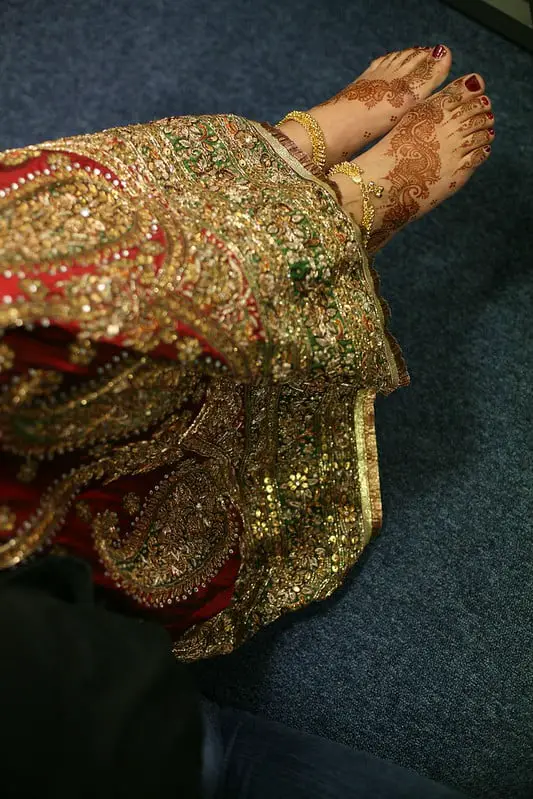
The mehndi is for all the women guests and is great for female bonding open to all ages and a great excuse to have a laugh and generally enjoy the company of women of different generations as well.
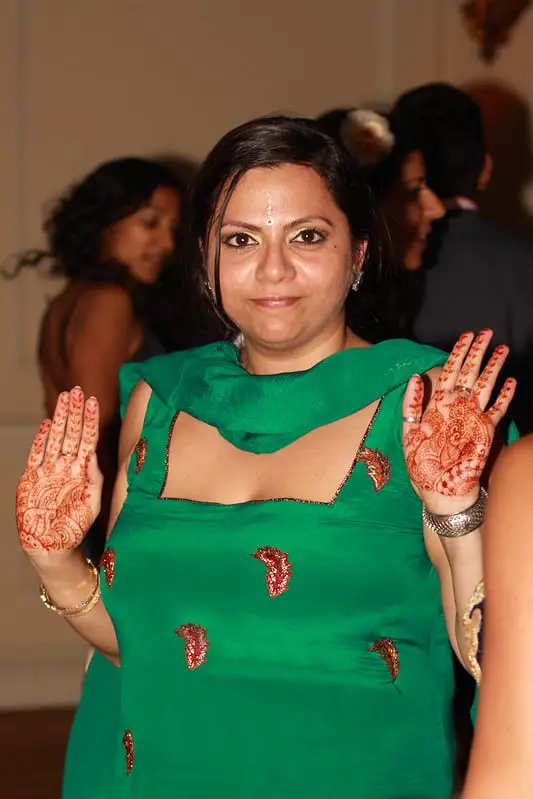
To compliment all the girls wedding outfits, you can have a basket containing bangles and bindis of all different sizes, styles and shapes which can either be placed somewhere for all the girls to choose from or the basket is passed around. This is great fun as all the girls choose the items to wear on the day and works as a little gift for girls to mark the occasion too, a great momentum of the day.
The mehndi is another occasion to celebrate and can have a party atmosphere with food and drinks being served. The groom will normally just have a dot of mehndi on his hands as a means of a blessing.
5. Choora
Choora is the collective name given to a set of bangles made specially for a bride to wear on her wedding day. This ceremony takes place at the bride’s house and I remember mine starting very early in the morning. It takes place on the day of the wedding. My Choora was provided by my mums’ eldest brother and it was and is still very special to me, even now.
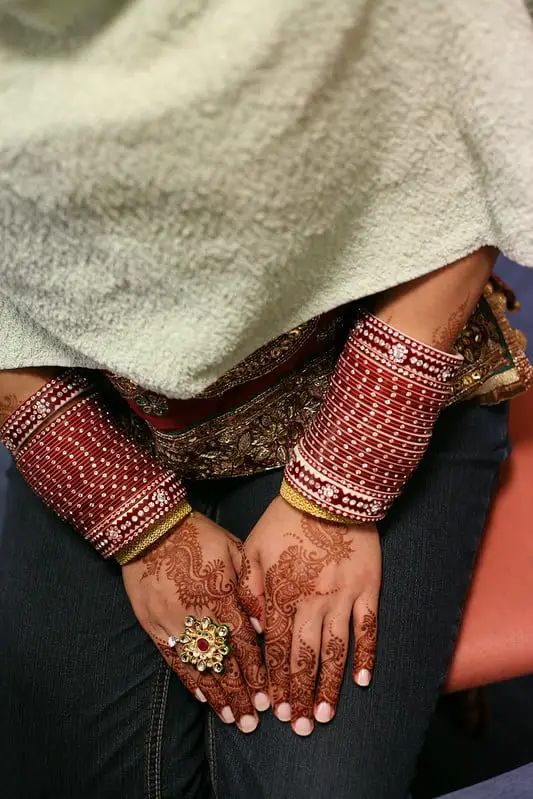
My choora was placed on a silver tray containing milk and few rose petals scattered around the tray. This not only made this look pretty, but it is said the milk softens the bangles and therefore makes it easier to slip on. Choora is normally a set of red bangles and varies considerably in design and decoration. It can be embellished with jewels and stones and you can incorporate a set with plain bangles and have some that are embellished.
There is a vast amount of variation options available on the market and the choice is quite varied. It can be a set of 12 or 24 for each hand. The Choora had an important place for my mother’s brothers and their wives as they perform the ritual of putting the bangles on me, the bride.
My mother’s brothers who were able to come to the wedding, together with their wives put my choora on for me and this was a very special and prominent moment for me as whilst they were putting the choora on, they were placing their hand on my head and giving me their blessings.
After the choora, my aunts and cousins put the kaliras on. The kaliras is a traditional accessory which goes hand in hand with the choora. It is very light weight and basically hangs down and looks a like chandeliers hanging from the choora. Like most brides, mine was gold in color.
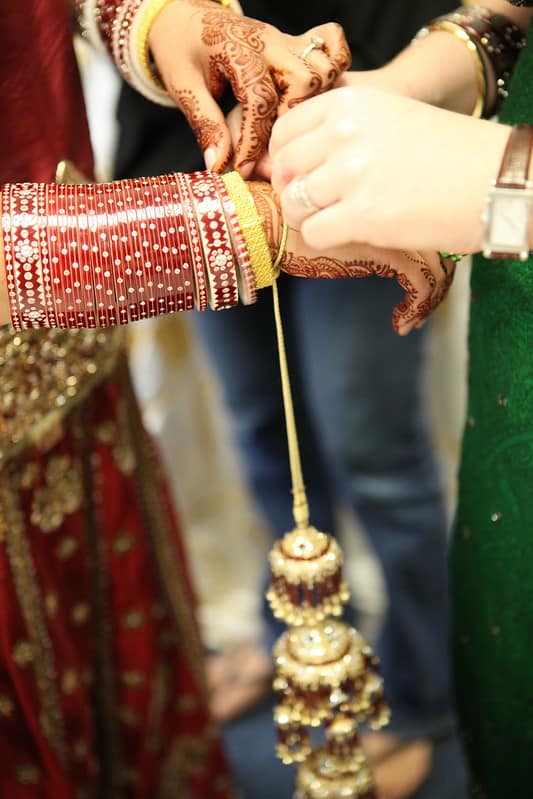
Traditionally a bride would wear her choora for 40 days and the custom is for the bride to refrain from heavy housework so that she can keep her choora intact and continue to wear it for this length of time. Obviously, in some instances this may not be possible as wearing 24 bangles for 40 days whilst working may not always be feasible.
6. Mayian
The Mayian is normally held in the evening and mine took place at my parents home, a day before the wedding. This can be an evening consisting of more than just one function and therefore not only saving you money but, it also cuts down on the number of functions.
You do not need to necessarily do each of the rituals on different days. My mayian consisted of the Batna, Vatna and Jaggo. You could even incorporate the Ladies Sangeet and the Mehndi too if you wanted to. According to the region of Punjab a Sikh comes from, may dictate the Mayian ritual varying slightly.
7. Vatna
Vatna is a paste made from using turmeric powder and mustard oil. It is said to give the bride a glowing complexion and to make her look even more beautiful and stunning on her big day.
I remember I had to wear an old Indian suit as obviously this can be quite a messy affair but, a fun ritual, nonetheless. It was rubbed onto my face, my arms, and the calves of my legs by my friends and all of my female relatives.
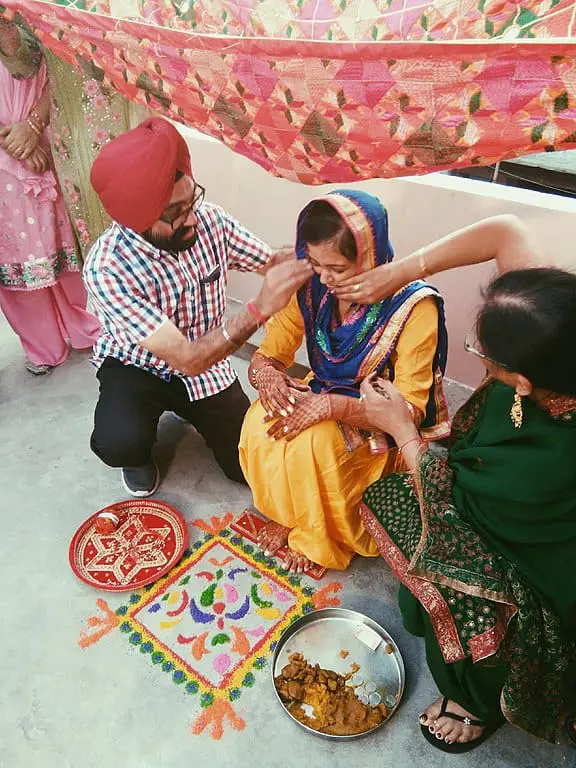
I remember all my guests thoroughly enjoyed rubbing this mixture into my skin and I think it actually did help to make my skin look both clearer and brighter. I was also surrounded by four diyas which were lit, and I had to sit continuously whilst facing them.
A diya is basically like an oil lamp. It is traditionally a clay pot, can be of any shape and size which has a cotton wick dipped in oil/ghee. During this ceremony it is important that the light does not go out and therefore you must ensure that oil is constantly poured on the diyas.
The reason behind the diyas is similar to the Vatna in that as the bride is looking at the glow from the diyas, the glow of the diyas is then reflected onto her face. Both the vatna and the diyas together, will ensure that the bride glows on her special day.
After this ritual is performed the bride and groom are not allowed to see each other until their wedding day. For me, it was quite nice to have some functions without my fiancé and his family around as it made it more personal for me and I enjoyed spending quality time with my family, and everyone was definitely more relaxed too.
8. Ghara Gharoli
In this ceremony, a decorative pitcher (gharoli also known as gara or ghadoli) is filled with holy water. The holy water was brought from the nearby Gurdwara (Sikh temple), by my brother’s wife, (Bhabi).
If you do not have a Bhabi then, the bride’s siblings or spouses could also go the Gurdwara to get the holy water. Before the bride wears her wedding outfit, she must bathe in the holy water.
Both the Vatna and the Ghadoli rituals were also taking place at my fiancé/groom’s house too. The only difference being that the pitcher of holy water was brought by his sister-in-law.
Traditionally the wedding outfits for both the bride and the groom are a present to them by their maternal uncles. However, now it is more common for the bride and the groom to either buy their own outfits or their parents buy the outfits for them.
I think in the times we live in now; tradition is very much mixed with individual personalities too. I was more than happy to follow the rituals but, chose to keep some traditions to suit me at the same time. In these modern times we live in, sometimes it is too expensive to follow each and every ritual.
I certainly, applied some of the rituals and traditions so that my family and I did not have a function each and every day until the day of our wedding. I wanted to enjoy few of the rituals but, still have time to relax and prepare for the big day. For me this was definitely the right choice and therefore I was able to enjoy my wedding day without feeling too tired or overwhelmed.
9. Jaggo
The Jaggo ritual is carried out using decorative vessels, normally made from copper or brass, as well as diyas (clay lamp). They are both filled with mustard oil and lit. This ceremony is normally performed at the wedding home during the night.
Another occasion for the family to sing and dance. The wedding home can also be decorated with lights outside the house as well as inside and decorated with garlands of flowers. You can decorate the house anyway you want, you could use balloons and fresh flowers, there is no right or wrong way, it is very much an individual preference.
The jaggo was performed by my mothers sisters, (performed by both the bride and grooms maternal aunt). One aunt will carry the vessel on their head and a different aunt will be constantly shaking a long stick which has bells on it.
It’s a ritual performed by women, they keep visiting as many friends and families homes, they feasibly can and continue to dance and keep moving on to the next house. At each house, you will receive a warm and friendly welcome with sweets and drinks being served. This is a fun and joyous occasion with dancing and food.
10. Entrance of the Groom
The groom is accompanied by a Sarbala or Shabbala, (known as the grooms caretaker). They are normally a young relative either a cousin or the grooms nephew. They would normally be dressed either the same or in a very similar outfit to the grooms.
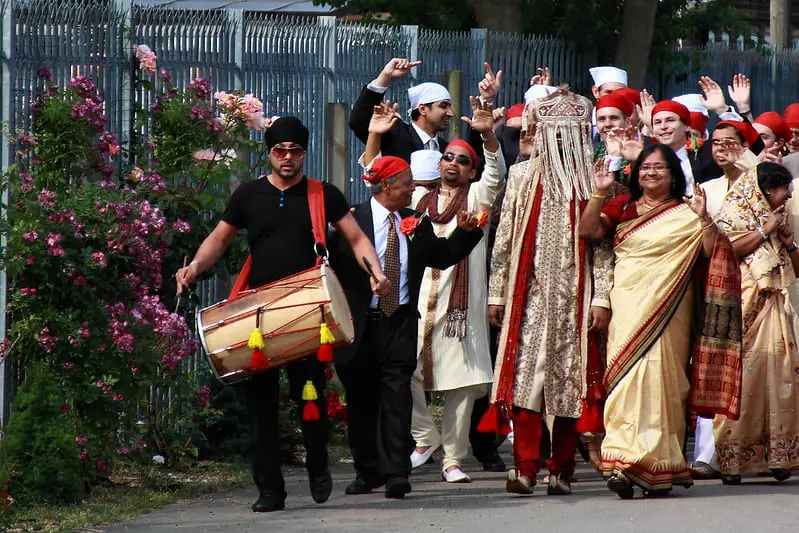
11. Barat
Traditionally for the entrance of the groom, the Barat ceremony, he would ride a horse or elephant accompanied by his Sarbala. Obviously, depending on where you live, this may not always be possible or allowed. So, the groom will quite often, use a more modern method of travel such as a car or a limousine.
12. Sehra
There are some rituals that occur at the grooms house which are the same as the brides. Before the groom is dressed in his wedding attire, he would have had the Vatna and Ghara Gharoli functions as well. A small puja or prayer is performed once the groom is dressed, followed by the tying of the sehra.
The sehra is a headdress which is tied by the groom’s sister. It is very similar to a brides veil; it decoratively covers the grooms face and consists of flowers or beads or you could combine both together and is tied on the grooms pagri (turban). After the sehra is tied, good wishes are bestowed to the groom in the form of cash or gifts.
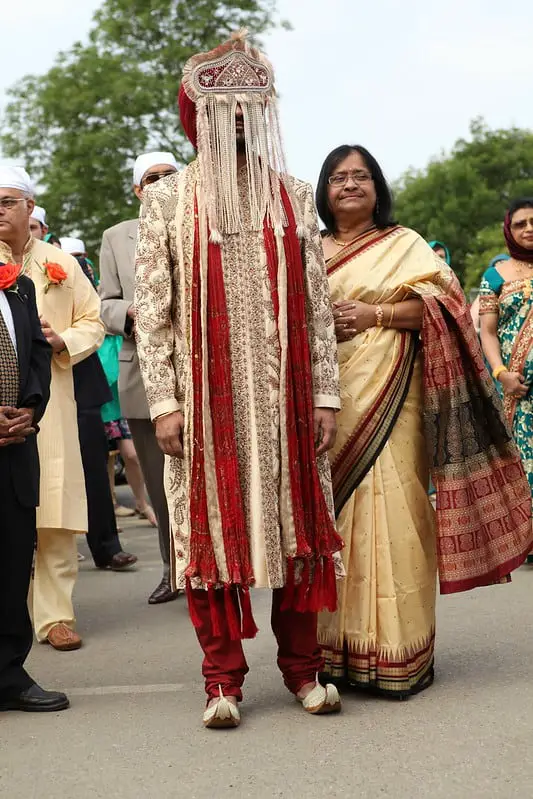
13. Varna
The Varna ritual is carried out by the grooms Bhabi (grooms sister-in-law), and it is said to ward off the evil eye. This is done traditionally using surma (eyeliner) on the grooms eyes. This is a very traditional ritual and in modern times, it seems most grooms don’t comply with this particular tradition but, will happily agree to a black dot marked behind the ear which basically works in the same manner as a surma and is said to keep the evil eye away from the groom.
14. Ghodi Chadna
If the groom can ride a horse, then this is the final ceremony. It is performed by the grooms cousins and sisters and is carried out at the grooms place. The ritual consists of adorning the mare and feeding it. Cash is used to ward of the evil eye by performing the Varna ceremony. All the cash is collected and given to the poor. The groom can now leave his house and travel to the wedding venue riding his horse.
15. Milni
Milni is the first ceremony to take place at the venue of the marriage, generally in the Sikh temple, the Gurdwara. The Milni is simply is the introductions of the two families i.e. the bride and the groom’s families. Ardas (prayers) are performed by the Gyani (someone in charge of the Sikh scriptures).
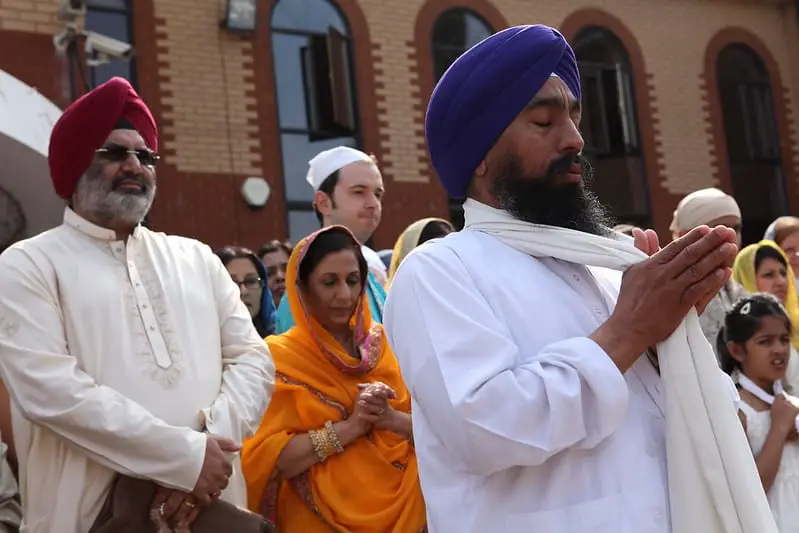
The Milni is for the men only in both families. The Milni starts with the eldest in each family, they come together to embrace each other and exchange garlands.
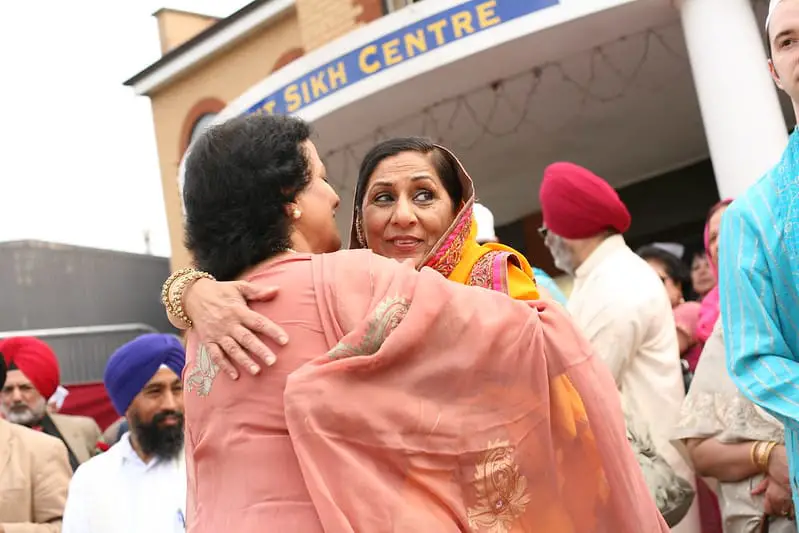
The ritual is carried out in the descending order of age. The garlands are normally made with flowers.

This is a great way to know and meet the members of each of the families. As a way of wishing luck to the groom, also known as Shagun, clothes and cash are gifted to the groom’s close relatives.
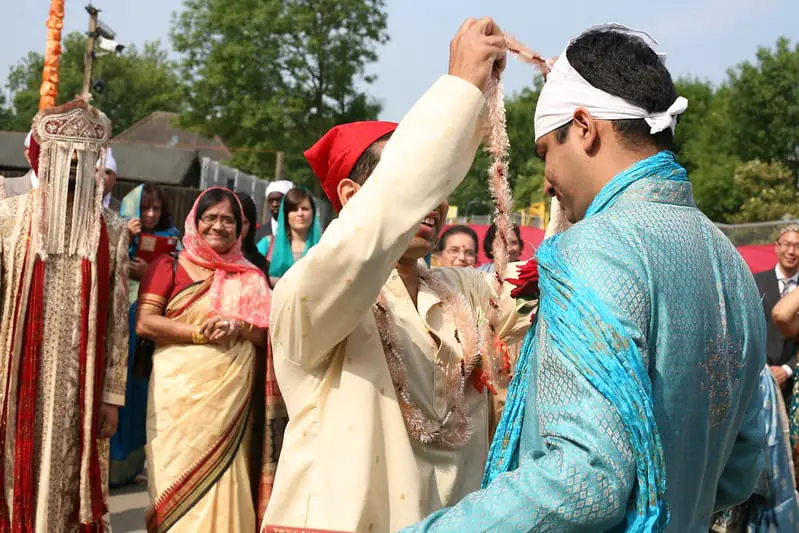
16. Jaimala
The garland of flowers are also exchanged by the bride and the groom. The Jaimala ritual is carried out after the Milni when both the bride and groom come in the middle where they are encircled by their families. The flower garlands (varmala) for the bride and groom will be quite considerably more lavished and heavier.
17. Anand Karaj
Traditionally the religious part of the Sikh wedding known as the Anand Karaj is performed in a Gurdwara, (Sikh temple). However, most couples are now opting for holding their weddings in hotels, halls or purpose built wedding venues.
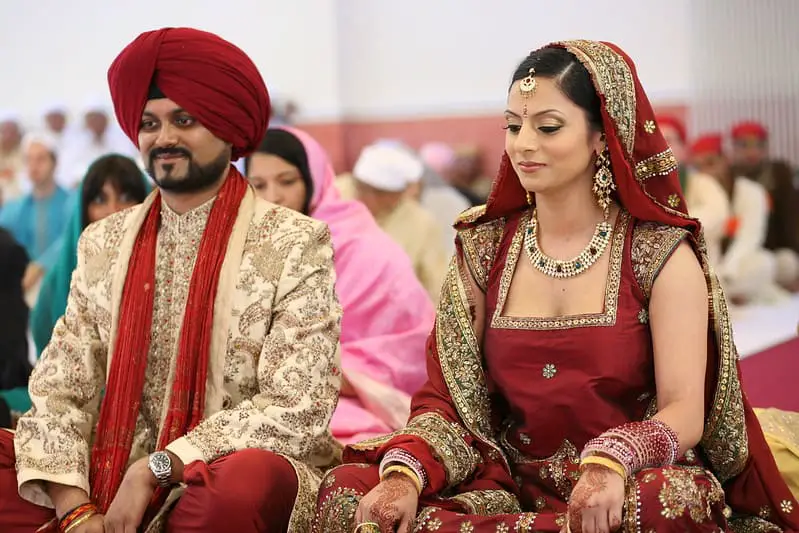
When I got married, I wanted to do something different, much like any other bride. I didn’t want the traditional setting of a Gurdwara, so I actually got married in a lovely Manor House and set-up one of the main halls as a Gurdwara with the Guru Granth Sahib, (Sikh holy book) and a Sikh priest to carry out the ceremony.
The bride and groom, in a Sikh wedding, carryout the lavaans, (walking in tow around the Guru Granth Sahib). They walk around the Guru Granth Sahib four times. This signifies that the couple the Guru is not only at the center of their marriage but, also that the couple accept each other as one soul in two bodies.
18. Joota Chupai
The Joota Chupai ritual is great fun and tradition and is carried out by the brides sisters and cousins and literally means ‘hiding’ the shoes. The grooms shoes are stolen and the girls who have stolen the grooms shoes negotiates a price for the return of his shoes. When I got married my sisters and close cousin sisters demanded and negotiated cash for the return of my husbands shoes.
19. Vidaai
The post wedding rituals start with the Vidaai. I remember this to be a very tearful occasion for me. It marks the departure for all brides from their parents home. I remember throwing puffed rice over my head, which expressed my good wishes to my parents.
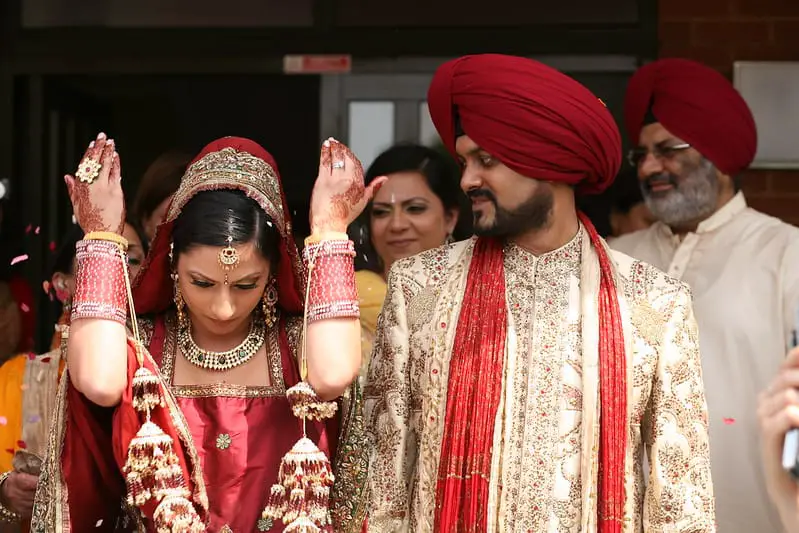
This was a very emotional time for me. Saying goodbye to my parents, my siblings and to the rest of my close family members made me extremely emotional.
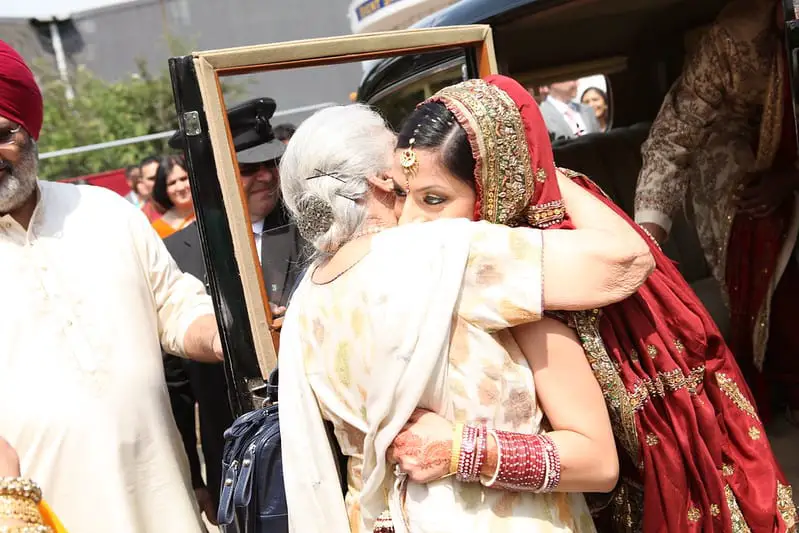
I was led to my husband and his family to start my new married life by my brother and my cousin brothers.
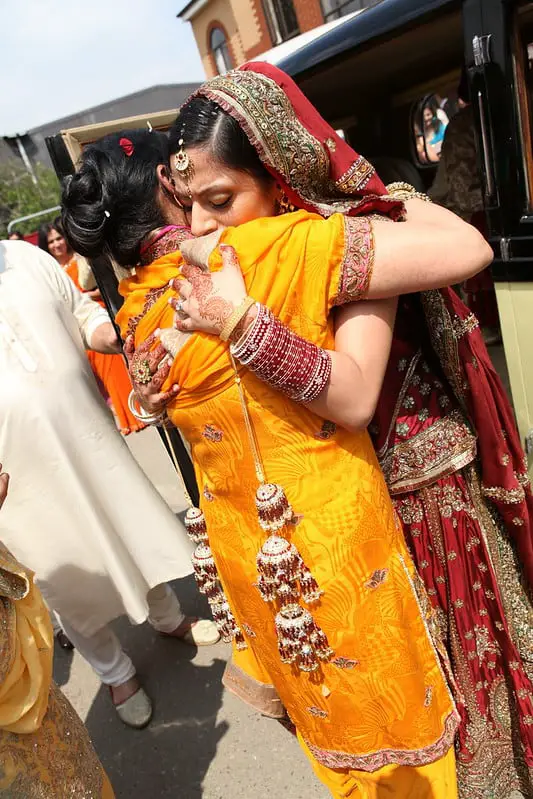
As we departed, my relatives were throwing coins in the wake of our procession.
20. Doli
During the Doli, the brides mother will be at home preparing to greet her new son-in-law and his new wife into the home, therefore, she would not be present during the ritual of the Doli. A glass of water was circled around my head, by my mother-in-law, three times before my mother-in-law offered it to me to drink, this showed her acceptance of me as her daughter but, also conveyed her blessings too.
21. Pani Bharna
At my husbands house, the ceremony of pani bharna was carried out. With my right foot, I had to kick a container containing mustard oil which was placed at the sides of the entrance. This ritual had to be carried before I could enter the house. The next ritual was matha tekna, which comprised of touching the feet of the elders.
22. Phera Dalna
The Phera Dalna takes place a day after the wedding when me and my husband were collected by my brother to visit my parents. My mother said a prayer at the entrance to her house and offered a gift before me and my husband could enter the house.
Summary
I have noticed that after I got married, which was about 17 years ago, my cousins have since had more lavish affairs where the guest list has appeared to increase in numbers too. To the extent that the number of guests appears to have exceeded the capacity of the venue.
It has become less intimate. Each generation seems to want to do something different when they get married, from getting married in a high-end hotel to getting married abroad.
The Indian wedding market is huge now. You have specially designed venues, which cater for guests ranging from 500+. The decorations are more lavish, each ritual has a day and evening dedicated to it and themes are organized. The gifts are more elaborate, and the jewelry and clothes given to the bride increasingly more elaborately decorated with gold threads, sequins and are heavily embellished.
Rather than having rituals carried out at home, some couples are opting for hiring out halls and restaurants. Not only that, couples are now investing their money on wedding planners so that they and their family members are less stressed and can ensure that everything is taken care of by someone else.
Obviously, this is very much a personal choice and there is no right or wrong way to precede with the traditions. Depending on personal funds the sky is the limit when arranging a wedding. As a couple you have to decide what you class as your perfect day and it is important that you can enjoy your day without getting into debt. You do not want to start your married life with a huge debt. Ensure that you have a set budget and you stick to that.
The best advice I can give, is that you talk to your parents and agree on what rituals they deem important and then set a budget. These days, costs can be shared with the groom and the bride. I had most of the pre-wedding and post wedding rituals and traditions carried out at my parents house.
My big day was in a beautiful Manor house with our close family members and friends. We had caterers who did a fantastic job with cooking delicious food but, also had staff to serve all tables and our guests. To us it was our ‘perfect’ day!!
Photo credits:
Main image: Best0657 by Ami and Debo Mukherjee is licensed under CC BY 2.0
[1] 2.3 by Ami and Debo Mukherjee is licensed under CC BY 2.0
[2] Ami&Debo37 by Ami and Debo Mukherjee is licensed under CC BY 2.0
[3] 2.1 by Ami and Debo Mukherjee is licensed under CC BY 2.0
[4] 2.9 by Ami and Debo Mukherjee is licensed under CC BY 2.0
[5] 2.1 by Rakzika is licensed under CC BY 4.0
[6] Ami&Debo02 by Ami and Debo Mukherjee is licensed under CC BY 2.0
[7] 3.11 by Ami and Debo Mukherjee is licensed under CC BY 2.0
[8] 3.22 by Ami and Debo Mukherjee is licensed under CC BY 2.0
[9] 1.59 by Ami and Debo Mukherjee is licensed under CC BY 2.0
[10] 3.29 by Ami and Debo Mukherjee is licensed under CC BY 2.0
[11] 3.49 by Ami and Debo Mukherjee is licensed under CC BY 2.0
[12] Best0350 by Ami and Debo Mukherjee is licensed under CC BY 2.0
[13] 8.7 by Ami and Debo Mukherjee is licensed under CC BY 2.0
[14] 8.13 by Ami and Debo Mukherjee is licensed under CC BY 2.0
[15] 8.19 by Ami and Debo Mukherjee is licensed under CC BY 2.0
